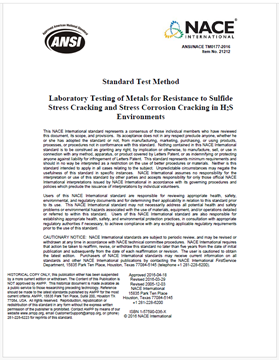Search
Products tagged with 'materials'
View as
Sort by
Display
per page
NACE SP0288-2011-SG (anteriormente RP0288), "Inspección de la Aplicación de Recubrimiento Interior en Equipos de Concreto (Hormigón) y Acero"
Product Number:
21182-SG
ISBN:
1-57590-180-3
Publication Date:
2011
$179.00
NACE TM0177-2016, Laboratory Testing of Metals for Resistance to Sulfide Stress Cracking and Stress Corrosion Cracking in H2S Environments
Product Number:
21212-SG
Publication Date:
2016
$179.00
Novel Acrylic Epoxy Hybrid Coatings for Metal Protection Applications
Product Number:
41216-966-SG
Publication Date:
2016
$20.00
Plural-Component Material Application Does Not Have to be Difficult
Product Number:
41213-758-SG
Publication Date:
2013
$20.00
RP0475-1975, Selection Of Metallic Materials to be Used in All Phases of Water Handling for Injection into Oil Bearing Formations
Product Number:
53028-HD1975
Publication Date:
1975
$179.00
SP0391-2016-SG (Formerly RP0391), Materials for the Handling and Storage of Commercial Concentrated (90 to 100%) Sulfuric Acid at Ambient Temperatures
Product Number:
21050-SG
ISBN:
1-57590-126-9
Publication Date:
2016
$109.00
SP0407-2018-SG, Format, Content, and Guidelines for Developing a Materials Selection Diagram
Product Number:
21123-SG
ISBN:
1-57590-212-5
Publication Date:
2018
$109.00
SP0407-HD2013-SG, Format, Content, and Guidelines for Developing a Materials Selection Diagram
Product Number:
21123-HD2013
ISBN:
1-57590-212-5
Publication Date:
2013
$179.00
SPECIALTY PACKAGE: Application of Railcar Coating Systems-2008-HISTORICAL VERSIONS
Product Number:
21855-SG
$350.00
SPECIALTY PACKAGE: NACE/SSPC Joint Surface Preparation Standards Package 2006-2018
Product Number:
21856-SG
$350.00
TM0104-2004-SG Offshore Platform Ballast Water Tank Coating System Evaluation
Product Number:
21243-SG
ISBN:
1-57590-193-5
$109.00












